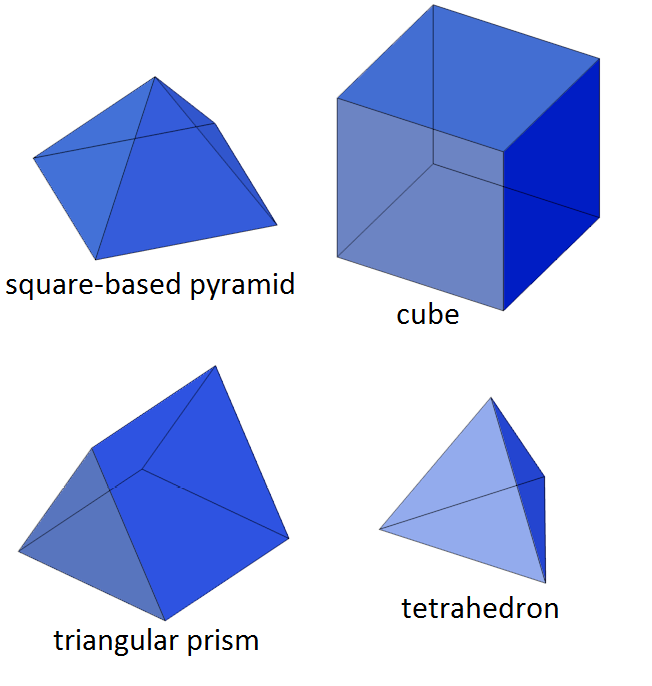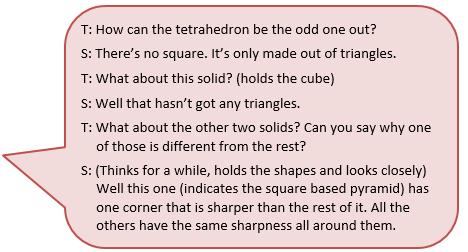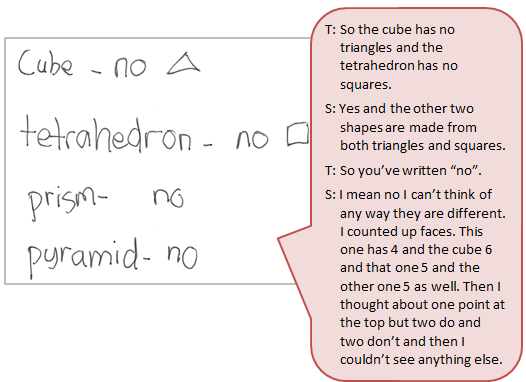The purpose of this activity is to engage students in identifying and sorting solids by the plane shapes of their faces.
This activity assumes the students have experience in the following areas:
- Naming common polygons and other 2-dimensional shapes.
- Naming common solids.
- Sorting 2-D and 3-D shapes by their features and properties.
- Identifying the properties of individual shapes and solids, including symmetries, parallelism of sides/faces, number of edges and vertices (corners).
The problem is sufficiently open ended to allow the students freedom of choice in their approach. It may be scaffolded with guidance that leads to a solution, and/or the students might be given the opportunity to solve the problem independently.
The example responses at the end of the resource give an indication of the kind of response to expect from students who approach the problem in particular ways.

A teacher gave his students four solids and asked them to find the odd one out.
Fran said the tetrahedron was the odd one out.
Tony said the cube was the odd one out.
The teacher said they were both right if they could give a reason.
Can you give a reason for Fran and a reason for Tony to be right?
Are there any other of these solids that could be considered to be the odd one out?
The following prompts illustrate how this activity can be structured around the phases of the Mathematics Investigation Cycle.
Make sense
Introduce the problem. Allow students time to read it and discuss in pairs or small groups.
- Do I understand what is being asked? (Students need to realise how a game of ‘Odd shape out’ works.)
- Do I know what the words mean? (The meaning of terms like pyramid and prism need to be clear.)
- What are different types of solids do I already know? (Discuss familiar solids such as cubes and spheres.)
- What will my answer look like? (The answer will be a reason why each solid is different from the rest.)
Plan approach
Discuss ideas about how to solve the problem. Emphasise that, in the planning phase, you want students to say how they would solve the problem, not to actually solve it.
- What maths ideas are involved in the problem? (Types of solids, shapes that make the faces of solids, edges, vertices (corners).)
- What do I already know about solids? What types of solids do I know about? (This investigation is about polyhedral, solids that are bounded by polygons.)
- What strategies might I use? Making a table? Drawing diagrams or using a physical model? Starting with a simpler problem? (Starting with two solids and identifying similarities and differences will make the task easier.)
- How will I record my answer to help me find any patterns?
- What tools might be useful? (Physical models of the solids will be an important support for students.)
- How will I know when I solve the problem?
Take action
Allow students time to work through their strategy and find a solution to the problem.
- What properties are important when you are sorting solids?
- Have I tried sorting the solids by common properties? Is there more than one way to sort the solids?
- What are the differences among my shapes?
- Could listing the properties of each solid help me to see which solid does not belong?
- Can I group my shapes in a different way? How?
- Can I learn from what others are doing?
Convince yourself and others
Allow students time to check their answers and then either have them pair share with other groups or ask for volunteers to share their solution with the class.
- What is my answer?
- Do I have a reason for making each solid the odd one out?
- How might I convince someone else that my reasons are correct?
- What reasons did I find? Are there other reasons that could be used?
- Could I have solved the problem in a more efficient way? How?
- What could I find out next? What maths do I need to work on?
Examples of work
Work sample 1
The student attends to shape of faces and sharpness of corners when giving similarities and differences among the solids.
Click on the image to enlarge it. Click again to close.
Work sample 2
The student attends to the shapes of faces to establish criteria by which individual solids cannot be included with the rest.

